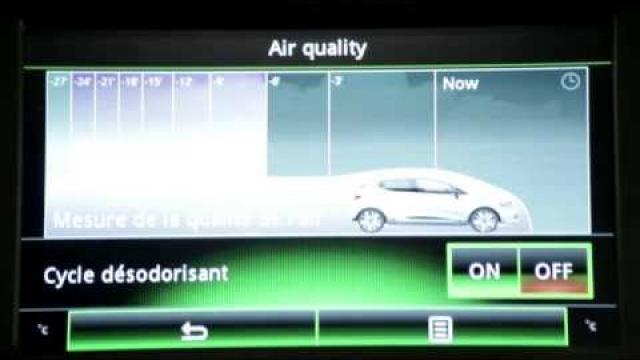AUTOMATIC CLIMATE CONTROL: control A

The controls
1 Stopping the system or, depending on the vehicle, de-icing/demisting the windscreen.
2 and 10 air temperature.
3 “Clear View” function.
4 and 5 Passenger compartment air distribution.
6 Fan speed and, depending on the ventilation, stopping the system.
7 Automatic programme.
8 Air conditioning.
9 Air recirculation.
11 De-icing/demisting of the rear screen and, depending on the vehicle, the door mirrors.
12 DUAL function.
Indicators
B Left-hand side air temperature.
C Distribution of air.
D Fan speed.
E Automatic air recirculation warning light.
F Right-hand side air temperature.
Automatic mode
The automatic climate control system guarantees comfort in the passenger compartment and good visibility (except in the event of extreme conditions), while optimising consumption. The system controls the ventilation speed, air distribution, air recirculation, and starting and stopping the air conditioning and air temperature.
AUTO: allows the selected comfort level to be best attained, depending on the exterior conditions. Press button 7. The integrated indicator light on button 7 comes on.
Varying the ventilation speed
In automatic mode, the system uses the most suitable amount of air to reach and maintain the desired comfort level.
You can still adjust the fan speed by pressing the buttons 6 to increase or reduce the fan speed.
In this case, the integrated indicator light on button 7 goes out and the ventilation speed selected is displayed on the indicator D.
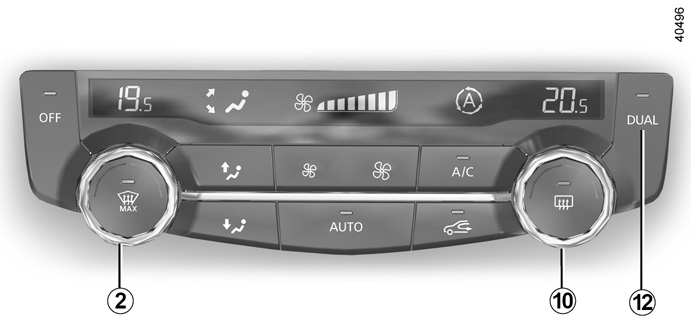
Temperature adjustment
There are two types of settings:
- uniform passenger compartment setting;
- adjustment in DUAL function to independently adjust the left and/or right-hand side of the passenger compartment.
Uniform passenger compartment setting
Use control 2.
DUAL function setting
Press button 12 to activate.
Use the control 2 to adjust the left side and control 10 for the right side.
The displayed temperature values show a comfort level.
When starting the engine, increasing or decreasing the value displayed will not allow the comfort level to be reached any more quickly. The system will always optimise the temperature increase or decrease (the ventilation system does not start instantly at maximum speed: it gradually increases). This may take several minutes.
Generally speaking, unless there is a particular reason not to, the dashboard air vents should remain open.
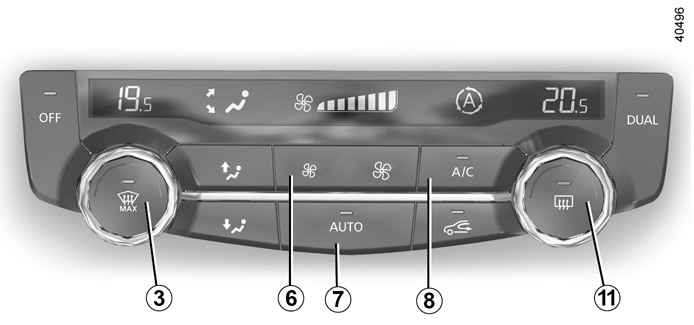
Switching air conditioning on or off
In automatic mode, the system switches the air conditioning system on or off, depending on the climate conditions.
Press the switch 8 to force activation (the integrated warning light comes on) or stop the air conditioning (the integrated warning light goes out).
Preferably, use automatic mode.
In automatic mode (warning light 7 is on), all climate control functions are controlled by the system.
You can always modify the choice of system; in this case, the warning light in the button 7 goes out.
To return to automatic mode, press programme AUTO.
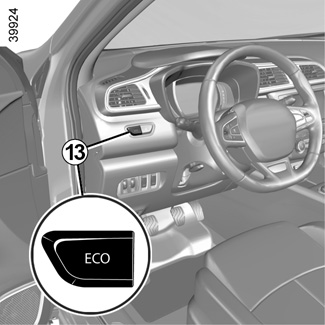
Vehicles fitted with the ECO mode (button 13): Once activated, the ECO mode may reduce the effective performance of the air conditioning. Please refer to the information on “Eco-driving” in Section 2.
Clear View function
This function quickly demists and de-ices the windscreen, the rear screen, the front side windows, and the door mirrors (depending on the vehicle). The air conditioning and rear screen de-icing functions must be activated.
Press button 3 - the integrated indicator light comes on.
To stop the operation of the rear screen, press the de-icer button 11. The integrated warning light will go out.
You can change the fan speed: press the button 6.
To exit this function, press button 3 again.
Some buttons have an operating tell-tale which indicates the operating status.
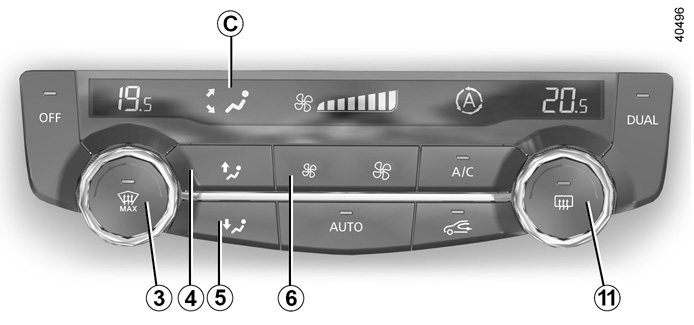
Adjusting the distribution of air in the passenger compartment
There are five air distribution options. Press switches 4 and 5 to scroll through them. The arrows located on the indicator C combine to show you the distribution selected:
õ All the air is then directed to the windscreen and front side window demisting vents.
÷ The air flow is distributed between front side window demisting vents, the windscreen demisting vents and the footwells.
ó The air flow is directed mainly towards the footwells.
G The air flow is directed to the dashboard vents and the footwells.
J All the air flow is directed to the dashboard vents.

De-icing or demisting the windscreen
(depending on the vehicle)
With the engine running, press the button 1 - the integrated indicator will come on.
This function enables quick electric de-icing/demisting.
Rear screen de-icing/demisting
Press button 11 - the integrated indicator light comes on. This function enables rapid demisting or de-icing of the rear screen and de-icing of the door mirrors (on equipped vehicles).
To exit this function, press button 11 again. Demisting automatically stops.
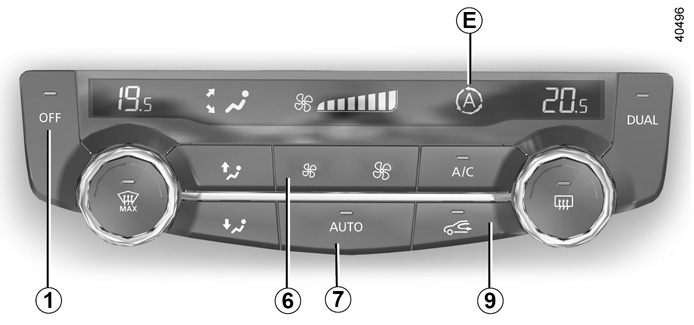
Recycling
This function is managed automatically (operation is confirmed by warning light E), but you can also activate it manually.
Note:
- during recirculation, air is taken from the passenger compartment and is recycled, with no air being taken from outside the vehicle;
- air recirculation allows the external atmosphere to be cut off (when driving in polluted areas, etc.);
- lowering the passenger compartment temperature as quickly as possible.
Manual use
Pressing the button 9 allows air recirculation to be forced. In this case, the integrated warning light comes on and the indicator E goes out.
Prolonged use of this position may lead to odours, caused by non-renewal of air, and the formation of condensation on the windows.
We therefore advise you to return to automatic mode as soon as air recirculation is no longer needed, by pressing button 9.
Stopping the system
To stop the system, press the button 1 OFF (the integrated warning light comes on) or, depending on the vehicle, reduce the fan speed down to a minimum by pressing the button 6 marked by OFF as many times as is necessary.
To start, press the switch 7.
The demisting/de-icing will still take priority over the air recirculation.
